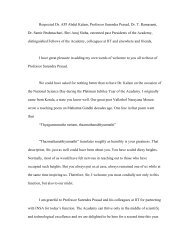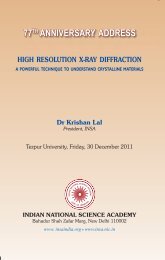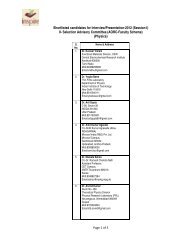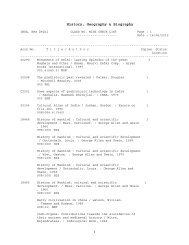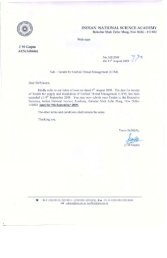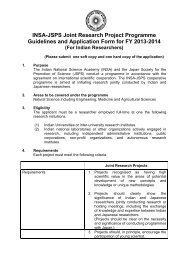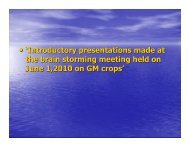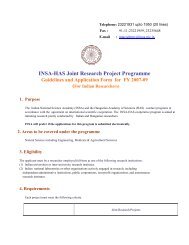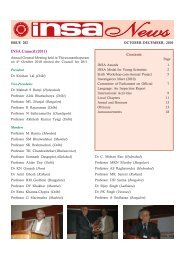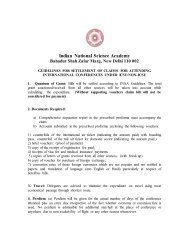Dr. B.Sesikeran
Dr. B.Sesikeran
Dr. B.Sesikeran
Create successful ePaper yourself
Turn your PDF publications into a flip-book with our unique Google optimized e-Paper software.
ANIMALS FOR HEALTH RESEARCH<br />
<strong>Dr</strong>. B.<strong>Sesikeran</strong>, MD, FAMS<br />
Director<br />
National Institute of Nutrition<br />
(Indian Council of Medical Research)<br />
Hyderabad – 500 007<br />
1
MAN DEPENDED ON ANIMALS<br />
FOR SURVIVAL<br />
• Food: Cattle, Sheep, Pig, Poultry<br />
• COMPETITION AND COMPANION SHIP<br />
• ACQUISITION OF KNOWLEDGE<br />
(Galen 129-200 AD - Wild deer, Artery<br />
contained blood not air)
RESEARCH IN ANIMALS OVER 100<br />
‣ Understanding of the basic functioning of mammalian<br />
physiology<br />
‣ Causes and process of disease<br />
‣ Mechanism of infectious diseases & immunity & Noncommunicable<br />
diseases<br />
‣ Methods to prevent them<br />
YEARS LEAD TO<br />
‣ Discovery of nutrients, anti-nutrients, non-nutrients,<br />
toxicants, antidotes, drugs etc.<br />
‣ Finally to help human & animals lead a relatively better<br />
quality of life
DISCOVERIES<br />
•1600’s - Discovery of blood circulation<br />
• Discovery of the function of the lungs<br />
•1700’s - Measurement of blood pressure<br />
•1800’s - Vaccination to stimulate immunity<br />
• Understanding of infectious diseases<br />
•1900’s - Discovery of antibodies<br />
• Understanding of hormone systems<br />
•1920’s - Discovery of vitamins<br />
•1930’s<br />
impulses<br />
- Discovery of the mechanism of nerve<br />
• Discovery of tumour viruses
DISCOVERIES (Contd..)<br />
1940’s - Understanding of embryonic development<br />
1950’s - Understanding the control of muscle activity<br />
1960’s - Discovery of monoclonal antibodies<br />
Understanding the biochemical functions of the liver<br />
1970’s - Understanding of transplantation antigens<br />
Understanding the way the brain functions<br />
Discovery of prostaglandins<br />
1980’s - Development of transgenic animals<br />
understanding the basis of memory<br />
1990’s - Understanding auto immune disorders<br />
In vitro fertilization, cloning, gene manipulation<br />
2000’s - Regeneration, stem cells, epigenetics
TRANSLATION OF DISCOVERIES<br />
1920’s - Insulin for diabetes<br />
1930’s - Modern anaesthetics for surgery, Diphtheria vaccine<br />
1940’s - Broad-specturm antibiotics for infections<br />
Whooping cough vaccine<br />
Heart-lung machine for open-heart surgery<br />
1950’s - Kidney transplants<br />
Cardiac pacemakers and replacement heart valves<br />
Polio vaccine<br />
<strong>Dr</strong>ugs for high blood pressure<br />
Hip replacement surgery<br />
1960’s - Corneal transplants<br />
Rubella vaccine<br />
Coronary bypass operations<br />
Heart transplants<br />
<strong>Dr</strong>ugs to treat mental illness
TRANSLATION OF DISCOVERIES (Contd..)<br />
1970’s - <strong>Dr</strong>ugs to treat ulcers<br />
Improved sutures and other surgical techniques<br />
<strong>Dr</strong>ugs to treat asthma<br />
<strong>Dr</strong>ugs to treat leukaemia<br />
1980’s - Immunosuppressant drugs for organ transplants<br />
CAT scanning for improved diagnosis<br />
Life-support systems for premature babies<br />
<strong>Dr</strong>ugs to treat viral disease<br />
1990’s - Laproscopic surgical techniques<br />
Breast Cancer Links<br />
Gene therapy for cystic fibrosis<br />
2000’s - Stem cell therapy
LABORATORY ANIMAL<br />
“Man made biological tool, nurtured in a<br />
controlled environment. Maintained on a<br />
standard diet free from known pathogens<br />
and of a defined genetic background”
WILD<br />
LABORATORY<br />
MOUSE<br />
RAT<br />
HAMSTER
WILD<br />
LABORATORY<br />
GUINEA PIGS<br />
RABBIT
World of Laboratory Animals
‣ Do we know everything about disease processes<br />
‣ Have we conquered all diseases<br />
‣ Do we have valid alternatives to lab animals<br />
• In silico - Simulations – Virtual<br />
– not real<br />
• In vitro - Single cell responses do not<br />
capture other variables<br />
• Lab animal studies have transformed therapy<br />
“Incurable” diseases to completely curable.<br />
• Facilitated early diagnosis<br />
• Led to minimally invasive procedures
Why not human models<br />
‣ Many confounding factors<br />
‣ Genetic variability<br />
‣ Phenotypical variability<br />
‣ Environmental variability<br />
‣ Cloned humans could be future<br />
“Lab animals”<br />
Until then………………………
FUTURE AGENDA<br />
‣ Developmental origins of adult health &<br />
disease - for better management<br />
‣ Cancer biology & therapy<br />
‣ Early biomarkers of pathological<br />
processes<br />
‣ Validation of alternatives to animal models<br />
14



